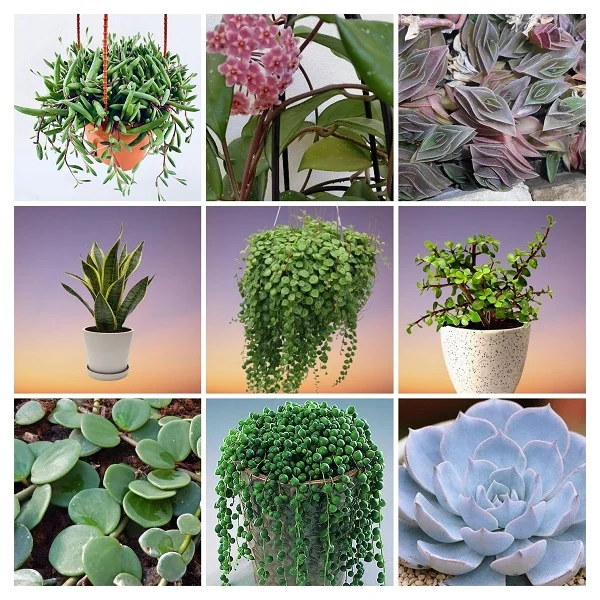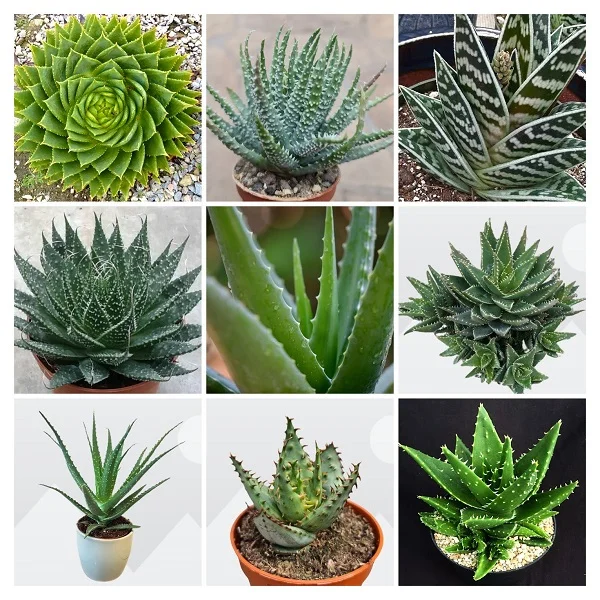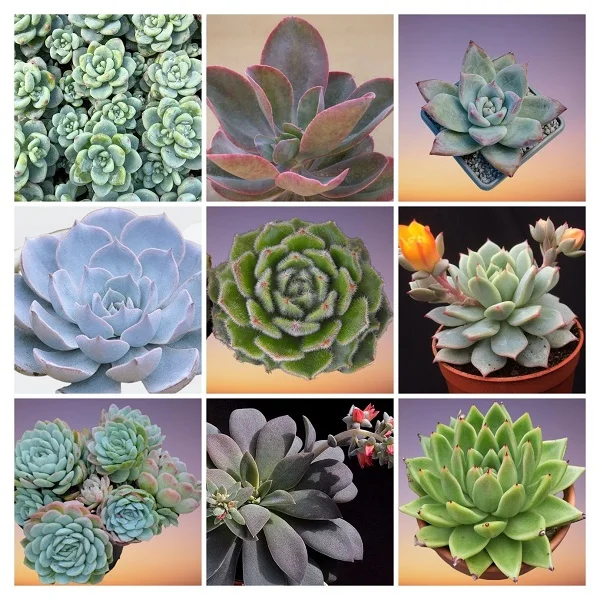14 Types of Haworthia Succulents with Names and Pictures
Some links in this post may be affiliate links
Haworthia bear firm, tough, fleshy leaves, usually dark-green in color while others are softer and contain leaf windows with translucent panels through which sunlight can reach internal photosynthetic tissues.
Haworthia Plants form a rosette of leaves from 1.2 inches to 12 inches in diameter and the flowers are white and small. When the plants are stressed like when deprived of water, their color can change to reds and purple. If deprived of nitrogen the leaves become paler.

Plants in the Haworthia Genus bear numerous offsets (pups) at the base of the plant which are used to propagate new plants.
The Haworthia Genus comprises of about 60 species which are endemic to Southern Africa; Mozambique, Namimbia, Lesotho, Swaziland and South Africa.
Haworthia Species grow best in bright light with 6-8 hours of direct sunlight, warmth of 18-260C, humidity of 50-55% and slightly moist, fertile, well-drained succulents soil coupled with monthly feeding during the growing season. Learn how to grow, care & propagate Haworthia succulents.
If you are looking to add these magnificent plants to your collection, we have outlined herebelow 14 Haworthia Succulents from which you can choose from.
14 Best Haworthia Types for Indoors
Best Haworthia Varieties for indoors are Haworthia attenuata, Haworthia pumila, Haworthia papillosa, Haworthia fasciata, Haworthia reinwardtii, Haworthia cooperi among others.
1. Haworthia attenuata (Zebra Haworthia)

Zebra Haworthia low-growing plant which bears succulent tapered leaves which have bands of white tubercles on them occuring on both upper and lower sides of the leaves.
Haworthia attenuata grows to a height of 6 inches and 5 inches wide. The flowers are white with green veins and appear from spring to fall, but indoors, it can bloom at any time of the year.
The species name, 'attenuata' means 'thinned, reduced, attenuated' or 'weakened, diminished' in reference to the leaves that narrow gradually to the tip.
2. Haworthia pumila (Pearl plant)

Pearl plant also called Pearl succulent or Cushion Aloe Plant is a spectacular plant which bears a tight rosette of blue-green leaves covered with white tubercles.
Haworthia pumila also called Haworthia margaritifera grows up to 12 inches tall and 6 inches wide. It produces greenish to brownish-white flowers with a waxy texture in summer.
Haworthia margaritifera is a succulent that looks like a miniature aloe. The plant can live for about 30 to 40 years if it is properly cared for.
3. Haworthia papillosa
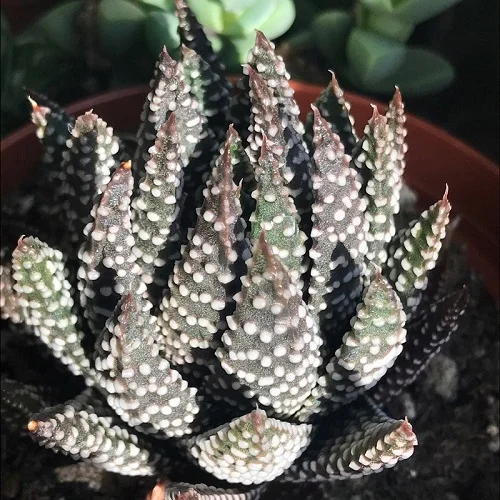
Haworthia papillosa is favoured for its dark green, erect and lanceolate leaves, with characteristic embossed, white points on both sides of the leaves.
The leaves are broad at the base, glaucous green or dull-green but reddish-brown in strong light and under stress. They are rather convex on the face, rounded on the back, slightly keeled towards the apex.
Large, creamy-white or beige, tubular-shaped flowers with pinkish (or greenish) tips, appear on long stems in late spring to summer.
4. Haworthia fasciata (Haworthiopsis fasciata)

Haworthia fasciata also called Haworthiopsis fasciata bears triangular-shaped, green leaves with narrow white crested strips on the outside where at the end of the leaf is a non acute spine.
Haworthia fasciata is often mistaken for Haworthia attenuata. One distinguishing feature is the smooth upper surfaces of the leaves in Haworthia fasciata.
The white tubercles occur only on the lower (outer) sides of the leaves in Haworthia fasciata but Haworthia attenuata has roughness or tubercles on both sides of its leaves.
5. Haworthia reinwardtii (Haworthiopsis reinwardtii)
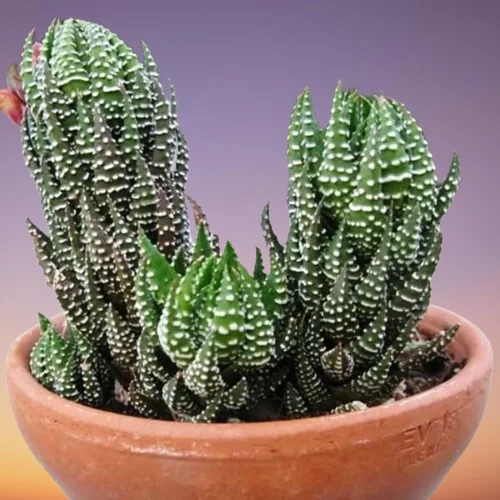
Haworthia reinwardtii is a perennial succulent which bears a basal rosette of white-spotted fleshy leaves arranged in a spiral pattern.
Haworthiopsis reinwardtii grows to a height of about 8 inches Racemes of tubular pinkish-white flowers appear in spring.
It is often mistaken for Haworthiopsis coarctata but Haworthia reinwardtii has larger, flatter and whiter tubercles on its leaves while those of Haworthia coarctata are smaller, smoother and rounder. In addition, Haworthia reinwardtii also has thinner, narrower leaves.
6. Haworthia cooperi
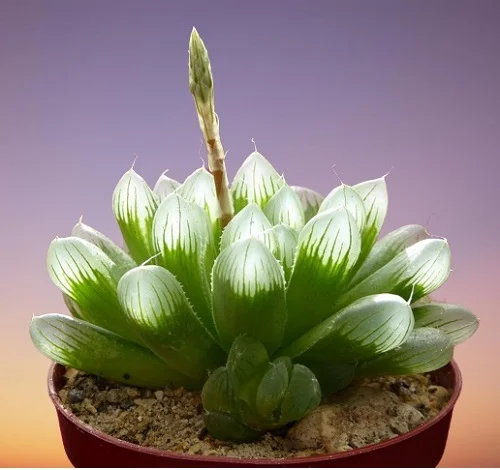
Haworthia cooperi is one of the soft green group of Haworthias which grows in clumps of small rosettes of tiny, fleshy, light green leaves.
The leaves have a slight bristley "awn" on the leaf margins and transparent streaks around the leaf tips.
It is a highly variable species, with several different varieties. It grows naturally in the summer rainfall lowlands region of the Eastern Cape Province in South Africa.
7. Haworthia cymbiformis (Star Window Plant)

Haworthia cymbiformis bears soft, boat-shaped leaves which usually have transparent streaks around their tips; ("cymbiformis" means "boat-shaped").
In its natural habitat where the sun is very bright, the plant grows mostly buried by sand with only the transparent tips above the ground to absorb light.
The species occurs on cliffs in the summer rainfall region between Port Elizabeth and East London in Eastern Cape Province, South Africa.
8. Haworthia retusa
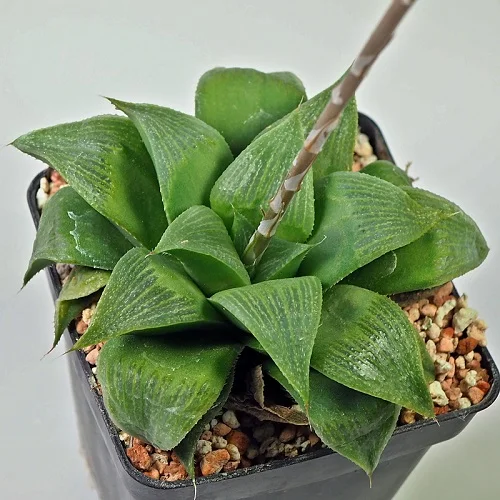
Haworthia retusa grow as tight rosettes of thick, firm, fleshy, highly recurved leaves where the upturned, recurved face of each leaf forms a triangle, which is transparent and often lined.
Haworthia retusa is one of the "retuse" species of Haworthia, which means that it usually grows sunken beneath the ground with its flattened leaves only showing on the surface.
It is indigenous to the lower hills and flatter terrain of an area around Riversdale, Western Cape, South Africa. In the UK it has gained the Royal Horticultural Society's Award of Garden Merit.
9. Haworthia bolusii
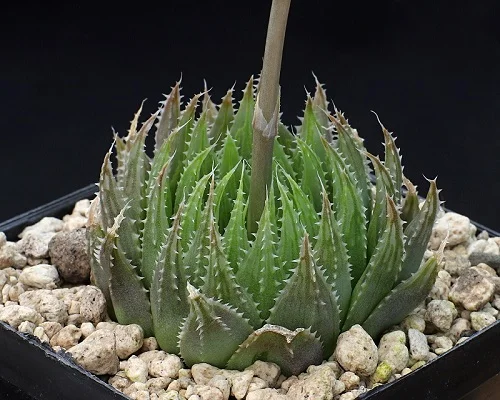
Haworthia bolusii bears fleshy leaves arranged in a basal rosette which are incurved, pale green with green longitudinal lines and white translucent bristles.
The long fibrous wavy bristles cover the leaves to form a web-like pattern. The flowers are white with brown or reddish-brown veins and appear mainly in late spring on a slender stem.
Haworthia bolusii grows to about 3.2 inches in diameter and produces offsets around the base to form small clusters. It is native to the northern part of the Eastern Cape Province in South Africa.
10. Haworthia tessellata (Veined Haworthia)
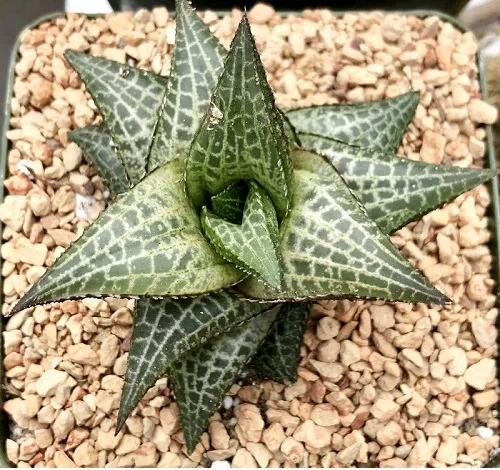
Haworthia tessellata is a small, slow-growing succulent which forms rosettes of fleshy, green to brownish leaves with a square patterned and windowed on the upper surface.
The leaves are broadly triangular, strongly recurved, firm in texture whose upper surface is marked with six pale green vertical lines and the lower surface is usually rounded and slightly covered with raised tubercles.
The margins of the leaves have recurved white teeth. The flowers are small, tubular, white with green midribs, and appear in summer.
11. Haworthia arachnoidea (Cobweb Aloe)

Haworthia arachnoidea forms a rosette of dark-green, triangular leaves with margins and keels with long translucent spines and a terminal bristle that is usually blackish.
It grows to about 7 inches diameter, is often solitary but may slowly develop pups to form a small clump. The flowers are white and appear from fall to spring.
Cobweb Aloe is found on rocky slopes and under bushes in the Breede River valley near Worcester and Robertson in the Western Cape Province in South Africa.
12. Haworthia truncata (Horse's Teeth)
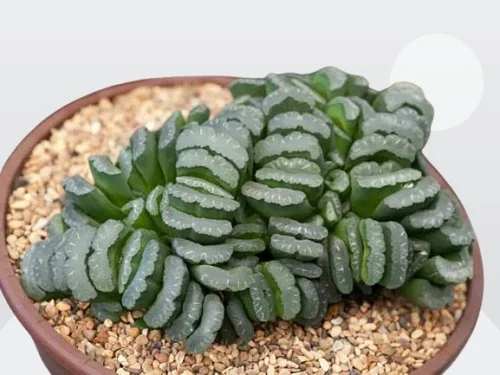
Haworthia truncata is easily recognizable by its gray or gray-green leaves which have a nearly rectangular crosssection and are arranged in two opposite rows.
The leaves are held more or less upright and the upper surface gives the impression of having been cut (or truncated), hence the species name, 'truncata'. They are covered with white or gray lines.
In their natural habitat, the plants are often half-buried, leaving only the tips of the leaves above the soil. The truncated tip has a leaf window which is translucent and allows light to enter for photosynthesis.
13. Haworthia angustifolia (Narrow-leaved Haworthia)

Haworthia angustifolia is a small succulent that forms rosettes of long, narrow, pale-green to dark-green leaves which turn brownish in full sun and bear a whitish terminal bristle.
It grows up to 3.2 inches wide, slowly offsetting to form small clumps. The flowers are white, pinkish, or reddish appear in spring and are borne on a slender, usually unbranched, up to 1 foot tall inflorescence.
The species name, 'angustifolia' means 'narrow-leaved' and derives from the Latin words 'angustus', which means 'narrow', and 'folium', which means 'leaf'.
14. Haworthiopsis limifolia (Fairy Washboard)
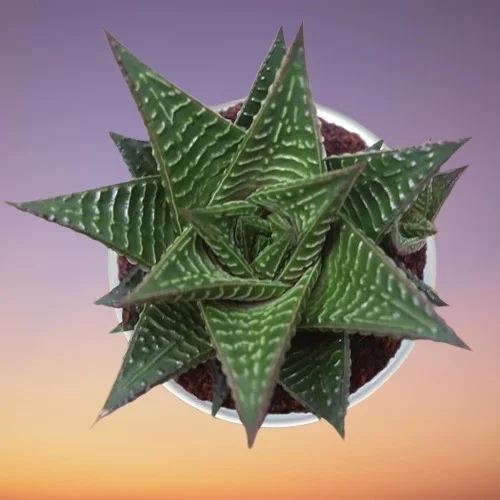
Haworthia limifolia also called Haworthiopsis limifolia bears a compact stemless rosette of light to very dark-green or brownish-green leaves with transverse ridges on both surfaces.
It grows up to 4.8 inches wide, slowly offsetting to form dense clumps. The flowers are white with a greenish-brown midrib, tubular, two-lipped and appear arranged in a raceme on a slender stalk in late summer and fall.
The species name, 'limifolia' means 'file-like leaves' in reference to the transverse ridges on the leaves. It is a compound of two Latin words, 'limes', meaning 'file' or 'sharpen', and 'folia', meaning 'leaf'.
